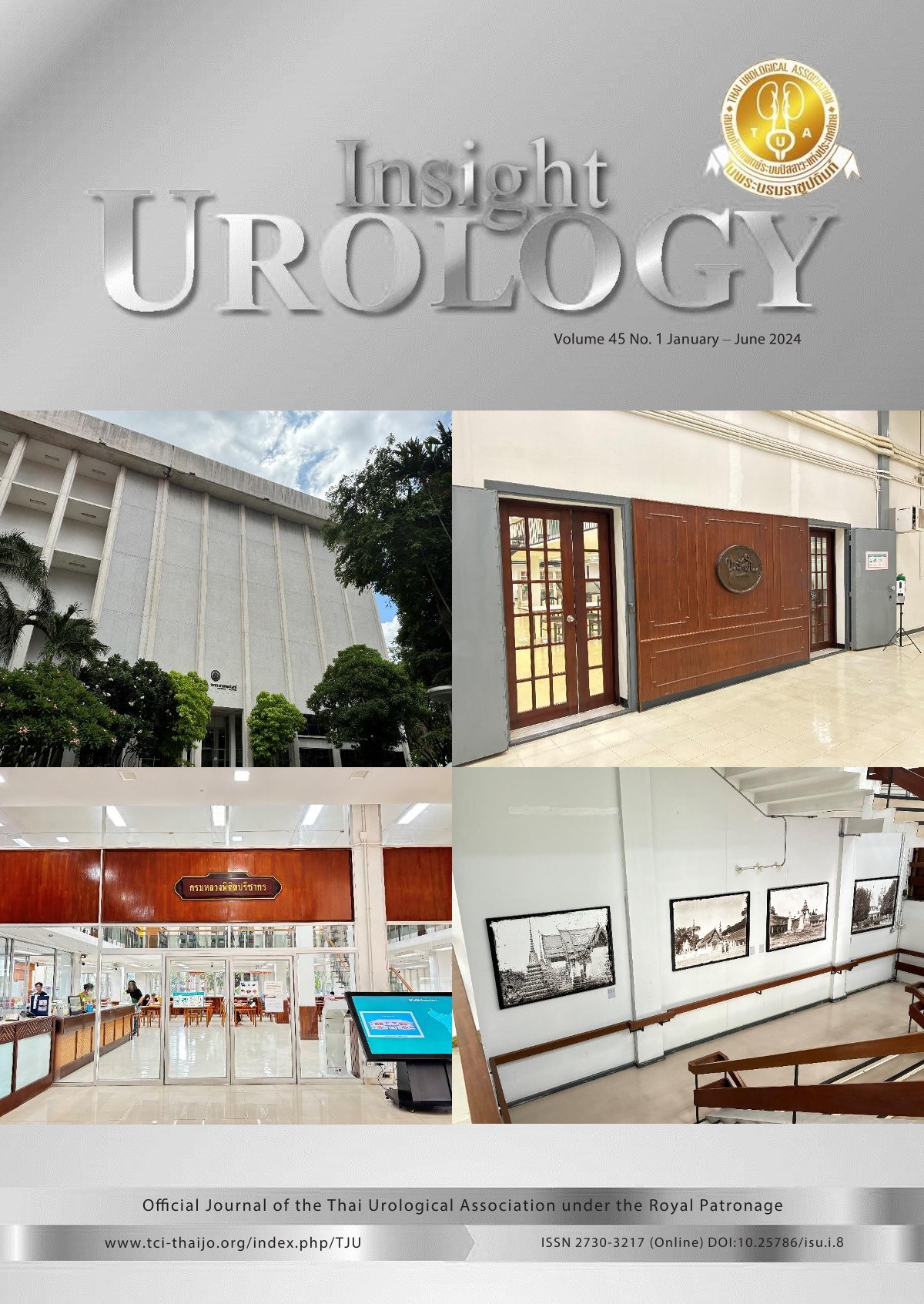Evaluation of therapeutic outcomes in emphysematous pyelonephritis: a single-center experience at Siriraj Hospital
DOI:
https://doi.org/10.52786/isu.a.82Keywords:
Emphysematous pyelonephritis, metabolic acidosis, urosepsis, nephrectomy, chronic kidney diseaseAbstract
Objective: Emphysematous pyelonephritis (EPN) is an acute, severe, necrotizing parenchymal and perirenal infection associated with high morbidity and mortality. The radiographic classifications, which determine the treatment strategies, however, remain controversial. Our study aimed to evaluate and compare the clinical parameters related to nephrectomy and the treatment outcomes in current practices.
Materials and Methods: We retrospectively reviewed the data from 21 EPN patients who had been diagnosed using computed tomography (CT) scans, who were admitted to Siriraj Hospital from January 2009 to December 2019. The clinical manifestations, imaging results, laboratory findings, treatment methods, and overall outcomes of each patient were reviewed and analyzed. Huang–Tseng’s and Wan’s classifications were used to classify the images obtained from the CT scans.
Results: Among the 21 patients with EPN, all had at least one comorbidity associated with a compromised immune response. Common manifestations included fever (74%) and initial laboratory findings showed hyperglycemia (66%), acute kidney injury (72%), and metabolic acidosis (76%). Inotropes were used in 13 patients for hemodynamic support. Eleven patients were treated with a non-nephrectomy approach, while 10 patients underwent nephrectomy. No statistical difference in treatment outcomes was observed between groups in both classification systems. Overall survival was 100% with a minimum one-year follow-up.
Conclusion: Our study demonstrated that the current treatment approach has resulted in a zero mortality rate of EPN most probably due to advancements in antibiotics, surgical techniques, and postoperative intensive care over the years. However, refining treatment strategies, considering radiographic criteria, clinical parameters, and initial treatment response, is essential in future studies to further decrease disease morbidity.
References
Michaeli J, Mogle S, Perlberg S, Heiman S, Caine M. Emphysematous pyelonephritis. J Urol 1984; 131:203-8.
Ahlering TE, Boyd SD, Hamilton CL, Bragin SD, Chandrasoma PT, Lieskovsky G, et al. Emphysematous pyelonephritis: a 5-year experience with 13 patients. J Urol 1985;134:1086-8.
Dutta P, Bhansali A, Singh SK, Gupta KL, Bhat MH, Masoodi SR, et al. Presentation and outcome of emphysematous renal tract disease in patients with diabetes mellitus. Urol Int 2007;78:13-22.
Falagas ME, Alexiou VG, Giannopoulou KP, Siempos II. Risk factors for mortality in patients with emphysematous pyelonephritis: a meta-analysis. J Urol 2007;178:880-5.
Somani BK, Nabi G, Thorpe P, Hussey J, Cook J, N’Dow J, et al. Is percutaneous drainage the new gold standard in the management of emphysematous pyelonephritis? Evidence from a systematic review. J Urol 2008;179:1844-9.
Tsu JH, Chan C, Chu W, Lae I, Kong C, Liu P, et al. Emphysematous pyelonephritis: An 8 year retrospective review across four acute hospital. Asian J Surg 2013;36:121-5.
Wan YL, Lee TY, Bullard MJ, Tsai CC. Acute gas-producing bacterial renal infection: correlation between imaging findings and clinical outcome. Radiology 1996;198:433-6.
Huang JJ, Tseng CC. Emphysematous pyelonephritis: clinic-radiological classification, management, prognosis, and pathogenesis. Arch Intern Med 2000;160:797-805.
Acute Kidney Injury Work Group. Kidney Disease: Improving Global Outcomes (KDIGO) - Clinical Practice Guideline for Acute Kidney Injury. Kidney Inter 2012;2:1-138.
Godec CJ, Cass AS, Berkseth R. Emphysematous pyelonephritis in a solitary kidney. J Urol 1980;124: 119-21.
Pontin AR, Barnes RD. Current management of emphysematous pyelonephritis. Nat Rev Urol 2009;6:272-9.
Pontin AR, Barnes RD, Joffe J, Kahn D. Emphysematous pyelonephritis in diabetic patients. Br J Urol 1995;75:71-4.
Tseng CC, Wu JJ, Wang MC, Hor LI, Ko YH, Huang JJ. Host and bacterial virulence factors predisposing to emphysematous pyelonephritis. Am J Kidney Dis 2005;46:432-9.
Olvera-Posada D, García-Mora A, Culebro-García C, Castillejos-Molina R, Sotomayor M, Feria-Bernal G, et al. Factores pronósticos en pielonefritis enfitematosa. Actas Urol Esp 2013;37:228-32.
Akpek S, Turgut T, Ozdemir H, Ilgit ET, Isik S. Emphysematous pyelonephritis: fatal outcome during percutaneous drainage. Eur J Radiol 1998;26:287-9.
Kapoor R, Muruganandham K, Gulia AK, Singla M, Agrawal S, Mandhani A, et al. Predictive factors for mortality and need for nephrectomy in patients with emphysematous pyelonephritis. BJU Int 2010;105:986-9.
Falagas ME, Alexiou VG, Giannopoulou KP, Siem pos II. Risk factors for mortality in patients with emphysematous pyelonephritis: a meta-analysis. J Urol 2007;178:880-5;quiz 1129.
Hsu C, Wu S, Yang S, Chang S. Emphysematous pyelonephritis: classification, management, and prognosis. Tzu Chi Med J 2022;34:297-302.
Aggarwal D, Mandal S, Parmar K, Manoharan V, Singh S, Yadav A, et al. Predictors of mortality and nephrectomy in emphysematous pyelonephritis: a tertiary care centre study. Ann R Coll Surg Engl 2023;105:323-30.
Sokhal AK, Kumar M, Purkait B, Jhanwar A, Singh K, Bansal A, et al. Emphysematous pyelonephritis: Changing trend of clinical spectrum, pathogenesis, management and outcome. Turk J Urol 2017;43:202- 9.
Downloads
Published
How to Cite
Issue
Section
License
Copyright (c) 2024 Insight Urology

This work is licensed under a Creative Commons Attribution-NonCommercial-NoDerivatives 4.0 International License.



